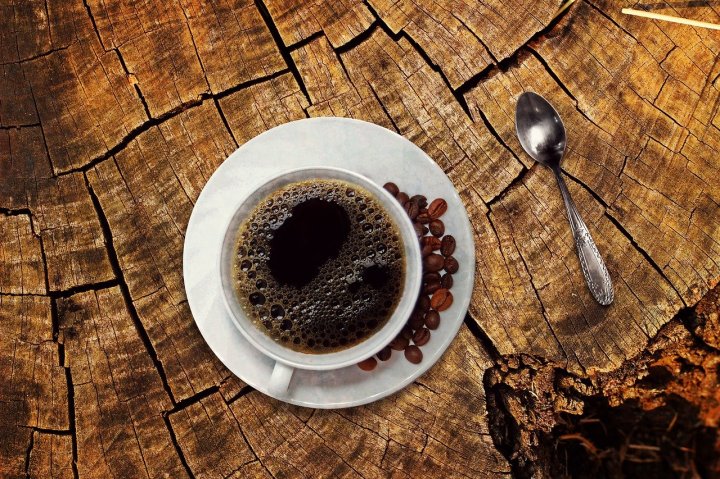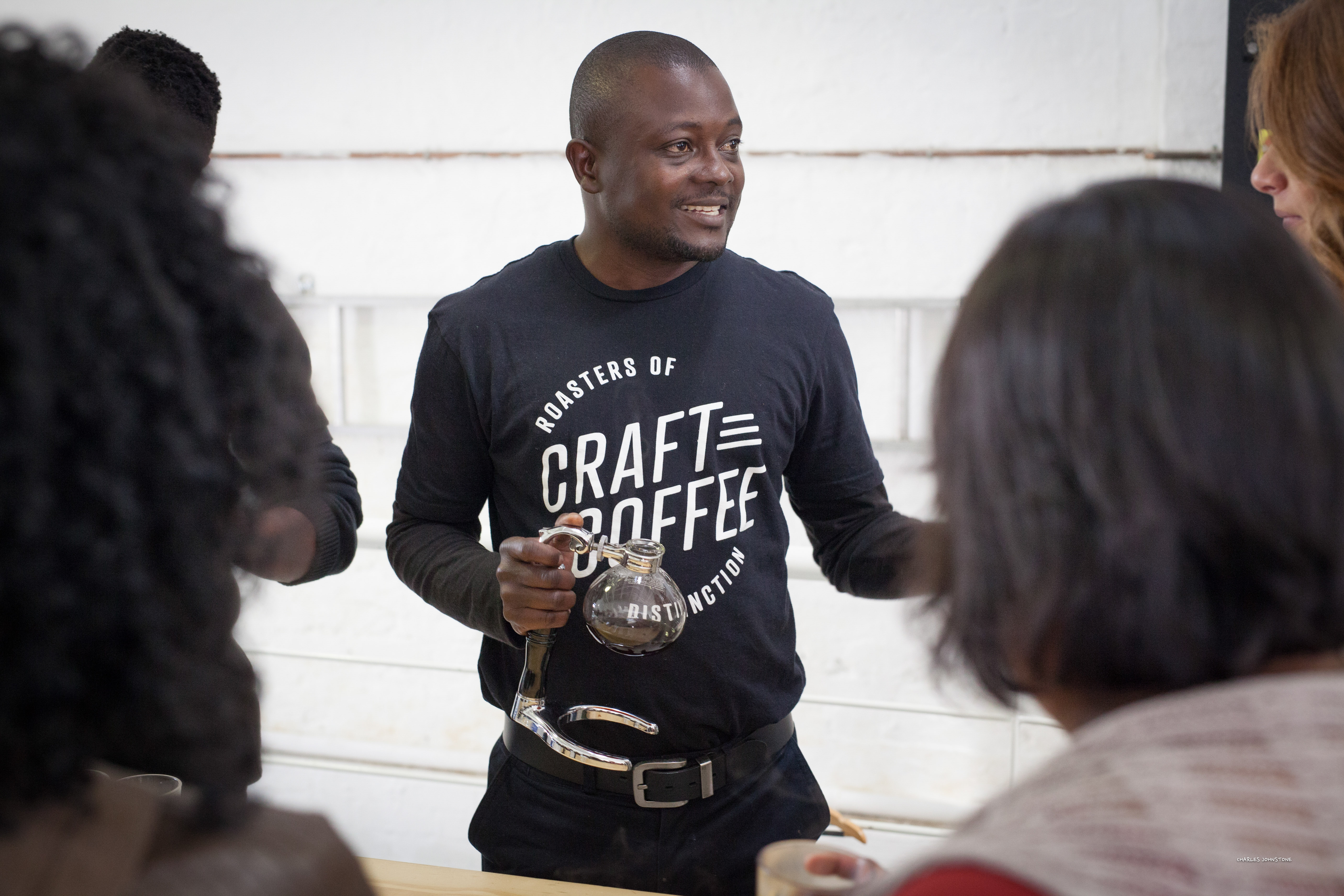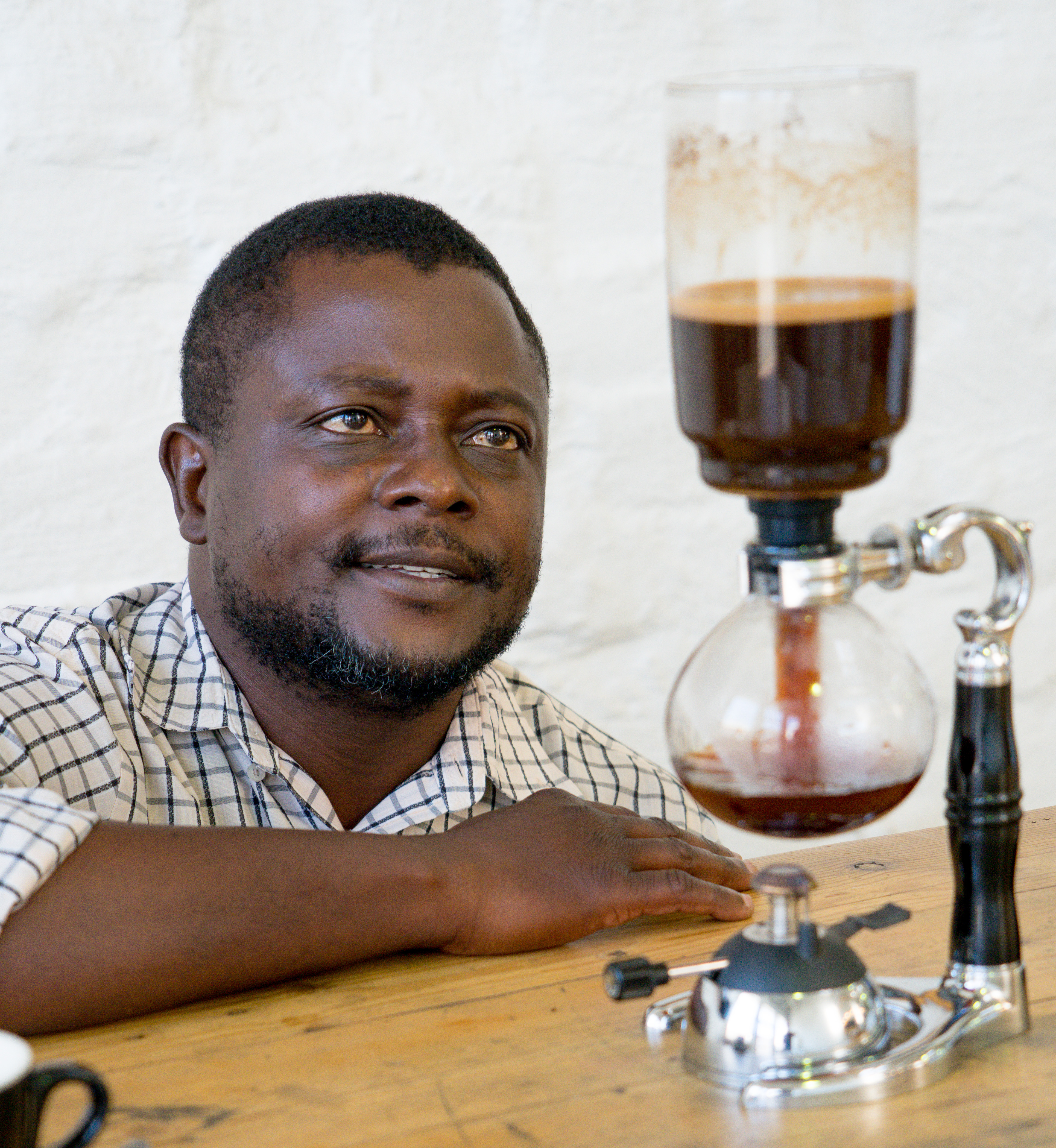BACK TO THE GRIND
How to lock down a great home brew

Yes, I know, I’m hardly aware that I always do it. And I know it’s a bit idiotic but I do say ‘Ahh’ with my first sip of coffee. I am aware though, thank you, that because I have so many coffees a day, I say it a lot. There are worse things.
So I’m the one that says “Ahh” and he’s the one that is making my Ahhs worthwhile.
He’s Lovejoy Chirambasukwa, barista’s barista. His card says he’s the roastery manager but it’s impossible to shake off the titles he’s won and then trained other baristas to win, nationally and internationally.
When I first met Lovejoy, I recognised him from his pictures in coffee magazines. Yet Lovejoy was once one of those guys sitting outside a petrol station in lower Woodstock, waiting for men in bakkies to load up human beings, generally those without papers, to do manual jobs for pittances. No arguments.

Lovejoy Chirambasukwa, the barista’s barista. (Photo: Supplied)
Lovejoy says he really enjoyed learning on his first job, which was painting. He watched the “boss” paint a little sample as a colour test and then did what he did, learning with each brushstroke and rollerstroke how to paint the owner’s flat. The second job as an alterations hand wasn’t as successful possibly because he wasn’t supposed to ask questions. Lovejoy offered to leave without any pay. That was when he read that Origin in Cape Town was prepared to introduce youths to the coffee business. “I put my all into it.”
I admire the way he and Craft Coffee still keep in with Origin, with Bean There and the other sustainable coffee places around South Africa.
“Always ask questions. About anything. We’re going to proceed with what works well,” said Lovejoy, wearing a lockdown beard, to me on Zoom. “And then you have fun working out what works for you, over time.”
Lockdown made me wonder why I’d been making average coffee at home and going out for, even seeking out, the fantastic stuff. Suddenly there was no sighing over coffee at places like Craft, where Lovejoy’s been for five years. How could I and others make the really wonderful coffees to sigh over at home now?

They would often suggest making coffees in alternative ways, here in a siphon. (Photo: Supplied)
I’d already realised that a grand, big espresso-cappuccino machine, like a big top hat, is not necessarily the secret to success, even for wealthier home baristas. That became evident, as an avid coffee drinker, especially at Craft where they would often suggest making one of their special coffees in a small press or as a pour-over. It was the first coffee shop I’d come across that had coffees of the day produced in a menu of different methods. But then it wasn’t really a coffee shop till quite recently. It roasted and sold coffee, and coffees to people who found their way there. It was and still is under a freeway on the factory end of Newtown.
“You want to make your coffee, not have it made for you by a big machine that automatically locks in all the processes.” In his personal coffee-making arsenal, Lovejoy has an Italian type moka pot, one of those enchantingly simple, stove-top, metal utensils. “It makes an espresso just as good, and probably better, than those expensive machines.” If you know a couple of the tricks with it, of course.
The other equipment many people have are French presses or plungers, aeropresses beloved by campers and a simple pour-over like mine. We decided to go though these four, gleaning from Lovejoy all the surprises, advice and secrets to making our own optimum, professional-at-home, barista-quality brews.
I was pleased Lovejoy didn’t say, “What did you expect?” When I owned up to not having a grinder, having ground my coffee beans in a blender before, with my fingers stuffed into my ears against the hailstorm effects. When that blender was replaced, the new one was too wimpish for the job and I started buying ready ground coffee. Lately my coffee has come out of lockdown local supermarket scurries, whatever-there-is brands. I’ve been drinking it with cream, to improve matters.
He just mentioned I should buy one and have it delivered with the two bags of coffee I was going to order (and he was going to choose). I gulped at the price for a manual grinder. Now that I’m over that, I far prefer the “true” feeling of using an obviously adept, very strong but neat crush-grinder. It also came with a fetching little black bag for taking it everywhere with me from now on, whenever that will be.
Of all the secrets to perfect coffee making at home, the size of the grind (hah – easy to select and produce on my new grinder) turned out to be more important than I’d imagined, as were the quantities of coffee ratio to water. But there were more.
For the French press or plunger, the grind needs to be coarse, “very coarse, like breadcrumbs”.
Good coffees for these presses are Ethiopian, Guatemalan or Brazilian, according to Lovejoy.
The presses come in three- and eight-cup sizes so, for the three-cup one, weigh out 19-21g of ground coffee (I’ve discovered 11-12gm is a flat Tablespoon of coffee).
First heat the jug with boiled water and swirl it out before adding the coffee grounds.
Measure out 300ml of boiling hot water into the plunge beaker and add just enough to the grounds to make a wet mash. If you have a timer, set it for four minutes, the time that the water will be in contact with the coffee before you pour it into your cups. After about 30 seconds into the time, mix the mash with a spoon, to release the bloom, and then pour in the rest of the water, giving it all one more stir.
Put the plunger into the beaker, the mesh part resting on the top of the water and coffee.
After four minutes in all, press it gently down and decant all the coffee into warmed cups immediately. “Don’t let the coffee stand or it will over-extract and be bitter.”
I was once told by a chef’s husband that he let it stand all night to make the coffee “nice and strong”. You can’t always trust chefs’ husbands.
For an aeropress, the easiest-to-clean, lightest option, the grind should be just a little less fine than for espresso (“and espresso is just a little less fine than Turkish coffee”).
Recommended coffees for this treatment are Ethiopian or a rather comforting Craft blend I’ve tried of Lovejoy’s, called Phoenix, which is Ugandan and Brazilian or something like their Rosebank, which is an interesting Ethiopian, Indian, Guatemalan and Brazilian!
Here you need 15-20g of coffee to what will be the fullest, which is 180-200ml of water.
Rinse the paper to get rid of that starchy smell and place it in the filter basket.
Construct your aeropress as usual but when you add boiling water almost up to the top rim, stir the grounds at the bottom with a spoon, to release some of their bloom.
From adding the boiling water to pouring the coffee it will take two minutes, in case you are timing it.
Then, when placing the filter basket onto the brew chamber, creating the pressure seal, swirl it, holding the two pieces together, before you place the aeropress onto a heated mug or jug and plunge down as the two minutes are up.
The hissing sound announces that the coffee is ready for immediate serving.
Regarding Lovejoy’s Phoenix blend, one of the two coffees, along with the Ethiopian Sidamo that had been delivered from Craft with my new grinder, I said that when I’d done a small coffee course once, something I took from it was that blends often need some weighty, full sort of taste and that Ugandan coffee often supplied that. I called it the Gorilla in the Midst on the course so that I’d remember it. I told Lovejoy but he didn’t even grin, saying it was too simplistic, going on about the farming height advantages of Ugandan and Rwandan coffees.
Those eight-faceted Moka pots produce delicious results but I’ve seldom seen even Italians or Cubans doing it the best way. This is it:
It starts with the grind being the second finest, ie ideal for espresso so one click coarser than for Turkish coffee.
Moka pots are self-measuring so that helps.
Pour boiling hot water, not cold water, up to the line in the bottom part when you fill the filter section with grounds.
Use a cloth for holding it because the bottom is very hot and stir the grounds with a little water, to dampen them and allow some of the bloom to emanate, before screwing on the pouring top half of the pot.
Put it on a medium hot plate to come to the boil.
“But people go off and take a shower while the coffee’s getting ready. They should be there when the pot starts hissing and bubbling.”
It should be poured out immediately into espresso cups or whatever you use.
Over many coffee drinking years, I’ve realised that the pour-over or drip method does it for me. One glance at my equipment shows it’s not pretentious though there are many rather exquisite arrangements I’ve seen, including that at Craft Coffee itself.
Here the grind needs to be quite coarse, not as coarse as for a French press but “like brown sugar granules”.
An Ethiopian or a Brazilian coffee or something like Craft’s Marshalltown blend of Brazilian, Ugandan and Tanzanian work well here. Note my gorilla in the midst again!
I have a mesh filter but if you use papers, rinse one first in warm to hot water to get rid of the starchy smell and taste.
Heat the jug with very hot water and pour it out.
Start by filling the filter with 20-24g coffee for 360ml water.
Boil the measured water and start pouring it slowly over the grounds. The process should take three minutes. Pause as soon as the grounds are wet and stir them. “Give them 20 seconds for the first bloom and then start pouring again, from the outer side of the filter to the centre, in decreasing circles, and then out again, in increasing circles, for the second bloom.” I think it opens up the flavour of the coffee.
Serve immediately when the three minutes are up.
I should mention that Craft’s location changed its circumstances in a strange way. The freeway pillars became a graffiti gallery and tourists first and then South Africans started admiring the works. There’s even a special cop there so that those with camera equipment needn’t be afraid of losing it. I guess they all smelled the coffee and found it. My special discovery began to be more like a coffee shop with little tables and even cake.

Craft’s location changed its circumstances in a strange way. (Photo: Supplied)
All along, people like me had also thought they were there roasting for orders of big, serious sacks of coffee. It turned out that they deliver even teeny orders to homes and individuals too. Then, I suppose, with Lovejoy’s personable character, the place has become quite pally, a place where you can get advice about your brews, no matter how domestic. Now, with lockdown, that works very well for us at home and for them and their staff.
Stuff like stirring the grounds and heating vessels as well as the techier things like weights and measures make the startling difference between okay coffee and being your home barista. But we mightn’t have known that without the help of Lovejoy Chirambasukwa. Three Ahhs. DM/TGIFood
Craft has offered advice any time to us from anywhere in the country, lockdown or not: [email protected]. You may even contact Lovejoy Chiramabasukwa, my coffee hero, on his phone: 071 0232438. www.craftcoffee.co.z





 Become an Insider
Become an Insider